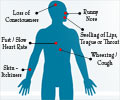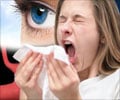Researches found that the life-threatening anaphylactic reactions to foods are under-diagnosed and under-treated, both in the community and in the emergency room. This was reported at the American Academy of Allergy, Asthma, and Immunology meeting after analyzing the two studies from Massachusetts General Hospital in Boston and the Albany (N.Y.) Medical College. F. Estelle R. Simons, M.D., of the University of Manitoba in Winnipeg, who is president of the American Academy of Allergy, Asthma and Immunology, said that Anaphylaxis is considered a rare disease by the physicians and other health care professionals.
Dr. Simons said that it is now known that the rate of anaphylaxis is likely to be much higher than published estimates. This is because anaphylaxis is experienced at home, school, camp, plane, bus etc. A consensus panel of the National Institute of Allergy and Infectious Diseases defined anaphylaxis as an acute onset of illness, within minutes to several hours, with involvement of the skin, mucosal tissue or both, following exposure to an allergenic substance, combined with one or more of the following: respiratory compromise, reduced blood pressure or associated symptoms of end-organ dysfunction, involvement of skin or mucosal tissues such as hives, and persistent gastrointestinal symptoms.Researchers at Massachusetts General Hospital and Harvard Medical School said that statistics show that even when anaphylaxis is recognized in the emergency room, only about 50% of the patients receive epinephrine to treat it. On the other hand about 25% of all such patients have symptoms serious enough to require hospitalization. Carlos Camargo, M.D., Dr. Ph., and colleagues drew on the National Hospital Ambulatory Medical Care Survey to study the number of patients on emergency department visits from 1993 to 2003.
It was concluded that anaphylaxis was identified by diagnostic codes for angioneurotic edema, unspecified adverse effect of drug, medicinal or biological substances when properly administered, unspecified allergy, and anaphylactic shock, food allergy, and other anaphylactic shocks. They found that acute allergic reactions account for more than one million emergency department visits each year, but only about 1% were recorded as anaphylaxis. Dr. Camargo said that patients with acute allergic reactions were increasingly likely to be given corticosteroids and histamine-2 blockers, but not epinephrine. Even among those with recognized anaphylaxis, only 53% received epinephrine.
Elinor Simons, M.D., of Albany (N.Y.) Medical College and colleagues in a separate study found that among families in which one or more children have severe food allergies, 81% did not receive pre-hospital epinephrine and 34% did not receive medical care for a severe reaction. In case of children suffering from anaphylaxis among 507 children only 59% were between the ages of 4-18 years and 37% were less than four years old. About 14% suffered from throat tightness, 33% from lower respiratory tract symptoms and 6 % from cardiovascular symptoms. But out of the 38% of the children who had one or more of these severe symptoms, only 6% were given epinephrine before reaching the emergency room.
Dr. Simons said that waiting too long could be fatal for some patients. Hence the American Academy of Allergy, Asthma, and Immunology (AAAAI) has launched a public information campaign to teach families, schools, physicians and other caregivers about anaphylaxis and how to handle it.











